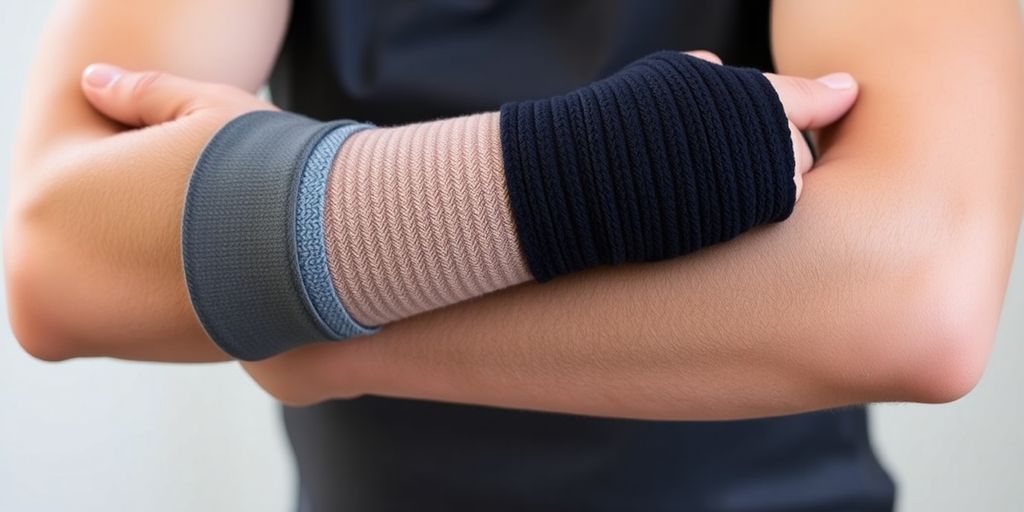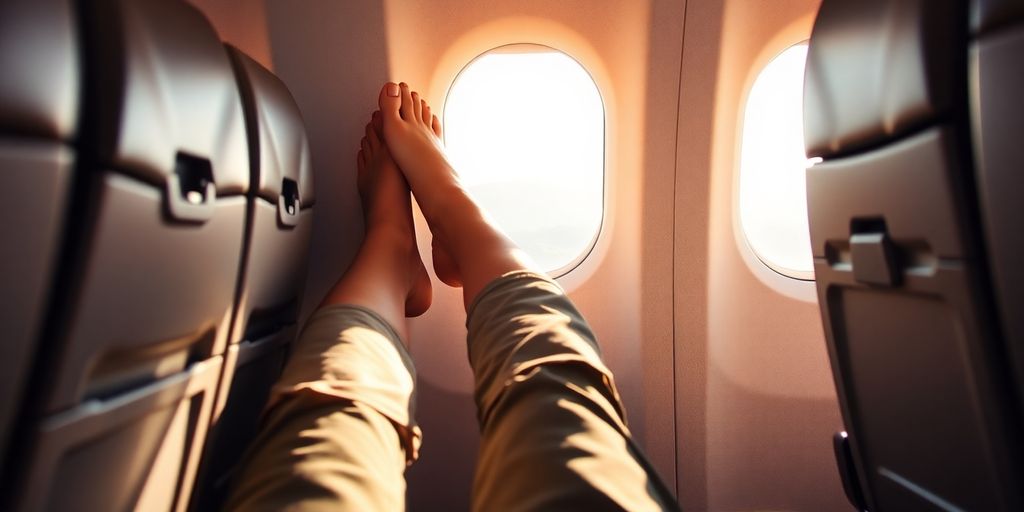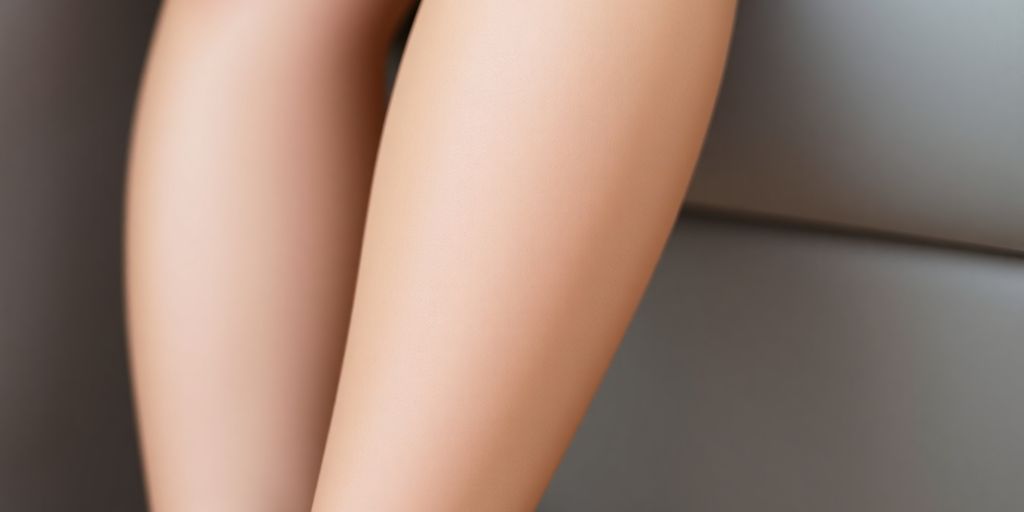So, you're thinking about getting some compression wraps for arms, huh? Maybe you're an athlete, or you're recovering from something, or you just want some extra support. Whatever the reason, picking the right ones can feel like a puzzle. There are so many choices out there! This guide will walk you through what to look for, from how they actually help your arms to what your doctor might tell you.
Key Takeaways
- Compression wraps for arms can help with muscle soreness and support, speeding up recovery.
- Good compression wraps fit well and are easy to put on and take off.
- Always talk to your doctor about what kind of compression wraps for arms are best for you.
- The material matters: look for medical-grade, breathable fabric that allows movement.
- Knowing the right compression level (light, medium, firm) is important, and your doctor can help you figure that out.
Understanding the Purpose of Compression Wraps for Arms
Compression wraps for arms aren't just a fashion statement; they serve several important functions, especially for athletes, individuals recovering from surgery, or those with certain medical conditions. They're designed to provide support and promote healing. Let's explore the key reasons why someone might use compression wraps.
Reducing Muscle Soreness and Fatigue
One of the primary reasons people use compression wraps is to reduce muscle soreness and fatigue. The gentle pressure applied by the wrap helps to stabilize muscles, which can minimize the vibrations and micro-tears that contribute to post-exercise soreness. Think of it as giving your muscles a little hug to keep them from getting too beat up. This is especially helpful after intense workouts or prolonged physical activity. Compression sleeves are a popular accessory in the fitness world, providing support and comfort during workouts. These tight-fitting sleeves are designed to apply gentle pressure to the arms or legs, which can help improve blood circulation.
Providing Joint and Muscle Support
Compression wraps offer support to both joints and muscles in the arm. This support can be beneficial for people with joint instability or those recovering from injuries. The wrap helps to keep everything aligned and reduces the risk of further injury by limiting excessive movement. It's like having an extra layer of stability that allows you to move with more confidence. Many find that compression garments also offer a second-skin feel that can reduce friction, chafing, and discomfort during long training sessions or competitions. The snug fit also helps keep everything in place, giving you the confidence to push your limits.
Aiding in Quicker Recovery Post-Exercise
Compression wraps can also play a significant role in speeding up recovery after exercise. By improving blood flow and reducing inflammation, these wraps help to deliver essential nutrients to the muscles and remove waste products more efficiently. This can lead to faster healing and reduced downtime between workouts.
Using compression sleeves during home workouts has many benefits. They help reduce muscle soreness and fatigue. They provide support to joints and muscles, potentially reducing the risk of injury. They can aid in quicker recovery post-exercise.
Here's a quick look at how compression aids recovery:
- Reduced swelling
- Improved blood flow
- Decreased muscle fatigue
Key Features of Effective Compression Wraps for Arms
When you're trying to find the right compression wraps for your arms, it's easy to get lost in all the options. But focusing on a few key features can really help you narrow things down and find something that works well for you. Let's break down what to look for.
Designed for Arm Anatomy
Generic compression gear might not cut it. You really want wraps specifically designed for arms. Think about it: arms aren't shaped like legs or torsos. Wraps made for arms will fit better, providing consistent pressure without pinching or bunching. This targeted design is super important for comfort and effectiveness. It's about getting that snug fit that supports without restricting.
Adjustable and Secure Fit
One size definitely doesn't fit all. Look for wraps with adjustable straps, hook-and-eye closures, or even zippers. These features let you customize the compression level and ensure the wrap stays in place, no matter what you're doing. A secure fit means the wrap won't slip during workouts or daily activities, and adjustability means you can fine-tune the pressure as needed. This is especially important after something like arm liposuction, where swelling can change over time.
Ease of Application and Removal
Nobody wants to wrestle with their compression wraps, especially when you're tired or sore. Wraps that are easy to put on and take off are a huge plus. This makes it more likely you'll actually wear them consistently, which is key for getting the benefits. Think about it: if it's a pain to use, you'll probably skip it. Plus, easy removal is important for hygiene and checking your skin.
Choosing the right compression wrap is a personal thing. What works for your friend might not work for you. Consider your specific needs, activity level, and any medical advice you've received. Don't be afraid to try a few different styles to find the perfect fit.
Doctor's Recommendations for Choosing Compression Wraps for Arms

It's always a good idea to get a professional opinion! Here's what doctors often suggest when picking out compression wraps for your arms. They see a lot of patients and know what works.
Consulting Your Surgeon for Specific Guidance
The best first step is to talk to your surgeon. They know the specifics of your situation, whether it's post-surgery or for managing lymphedema. They can give you tailored advice on what kind of compression sleeve will work best for you. Don't be shy about asking for specific product suggestions; protocols can change based on the procedure.
Selecting Reputable Brands
Stick with brands that are well-known and often recommended by surgeons. These companies usually have a track record of quality and effectiveness. It's worth spending a little more to get a product you can trust. Look for brands that surgeons are familiar with, as they'll know about sizing and compression levels from past patient experiences.
Prioritizing Correct Fit Over Aesthetics
Fit is key! A wrap that's too loose won't do much good, and one that's too tight can cause problems. Follow the sizing charts carefully, and don't hesitate to ask your surgeon for help with sizing. It's more important to get the right fit than to worry about the color or style. The goal is to minimize swelling and facilitate drainage, so focus on function first.
Getting the right compression level is super important. Your surgeon can tell you if you need light, medium, or firm compression. Don't just rely on standard size charts; get personalized advice for the best results.
Material Considerations for Compression Wraps for Arms
Medical-Grade Fabric Composition
When it comes to compression wraps, the material isn't just about comfort; it's about performance and safety. Medical-grade fabrics, typically a blend of nylon and spandex, are engineered to provide consistent and controlled compression. These materials are designed to withstand repeated use and washing without losing their elasticity or shape. Cheaper materials might stretch out quickly, rendering the wrap ineffective. It's worth investing in quality fabrics for long-term benefits.
Breathable and Comfortable Materials
Comfort is key, especially if you're wearing a compression wrap for extended periods. Look for materials that are breathable and wick away moisture. This helps prevent skin irritation and discomfort. Some options include:
- Microfiber blends: These are soft and allow for good airflow.
- Moisture-wicking synthetics: Designed to pull sweat away from the skin.
- Latex-free options: Important for those with latex allergies.
I remember getting a compression sleeve once that wasn't breathable at all. It was like wearing a plastic bag on my arm. I ended up with a rash and couldn't wear it for more than an hour. Lesson learned: breathability matters!
Flexibility for Full Range of Motion
While compression is important, you don't want a wrap that restricts your movement. The ideal material should offer a balance of support and flexibility. This allows you to perform daily activities or exercise without feeling constrained. Look for fabrics with a four-way stretch, which means they can stretch both lengthwise and widthwise. This type of material adapts to your body's movements, providing support without limiting your range of motion. Also, consider if you need arm sleeves versus full bodysuits. Adjustable closures can also help customize the fit and flexibility.
Determining the Right Compression Level for Arms
Choosing the correct compression level is super important for getting the most out of your arm wraps. It's not a one-size-fits-all situation, and what works for your friend might not be right for you. Let's break down how to figure out what you need.
Assessing Light, Medium, or Firm Compression Needs
First, think about why you're using compression wraps. Are you dealing with minor muscle soreness after workouts? Or are you recovering from a more serious procedure? The intensity of your needs will dictate the compression level. Light compression is usually good for everyday support and mild soreness. Medium compression is a step up, often used for post-workout recovery or managing mild swelling. Firm compression is typically reserved for post-surgical use or more significant swelling issues. Here's a quick guide:
- Light (10-15 mmHg): Daily wear, minor soreness, general support.
- Medium (15-20 mmHg): Post-workout, mild swelling, moderate support.
- Firm (20-30 mmHg or higher): Post-surgical, significant swelling, as directed by a doctor.
Following Surgeon's Pressure Guidelines
If you're using compression wraps after a procedure like arm liposuction, your surgeon's instructions are the law. They know exactly what pressure you need to minimize swelling and help with healing. Don't try to guess or adjust the compression level on your own. They might recommend combining arm sleeves with bodysuits for optimal results. Make sure you understand whether you need light, medium, or firm compression based on your specific case.
Understanding Sizing Chart Limitations
Sizing charts are a good starting point, but they aren't perfect. Everyone's body is different, and muscle mass, fat distribution, and other factors can affect how a wrap fits. Just because you fall into a certain size range doesn't mean that compression level is automatically right for you. It's better to get input from a surgeon on sizing. If possible, try on different sizes and compression levels to see what feels best and provides the right amount of support without being too restrictive. Remember, a high UPF rating is important if you're using the sleeves outdoors.
It's easy to get caught up in finding the perfect fit based on size charts alone, but remember that comfort and effectiveness are key. A wrap that's too tight can restrict blood flow and cause discomfort, while one that's too loose won't provide any benefit. Pay attention to how the wrap feels on your arm and adjust accordingly, always prioritizing your surgeon's recommendations if you're using it for post-operative care.
Exploring Different Types of Compression Wraps for Arms
Arm Sleeves Versus Full Bodysuits
When it comes to compression for your arms, you've basically got two main options: arm sleeves or full bodysuits. Arm sleeves are great because they target just the arms, offering support and compression where you need it most. They're easy to put on and take off, making them convenient for daily wear.
Full bodysuits, on the other hand, include arm sleeves as part of a larger garment. These can be beneficial if you need compression in other areas of your body as well, like your torso or back. The downside is they can be a bit more restrictive and less comfortable for some people. Think about what you need the compression for and how much coverage you want. For managing swelling from breast cancer circumcision, radiation therapy burns, and lymph outflow disorder, the MGANG medical arm sleeve is ideal for daily wear.
Combining Sleeves with Other Garments
One of the cool things about arm sleeves is how easily they can be combined with other clothing. You can wear them under regular shirts, jackets, or even workout gear. This makes them super versatile for different activities and situations.
- Need extra support during a weightlifting session? Throw on some compression sleeves under your workout shirt.
- Want to minimize swelling after surgery? Wear them under your regular clothes throughout the day.
- Trying to reduce muscle soreness? Wear them under your clothes after a long day.
It's all about finding what works best for you and your needs. Compression tops target the shoulders, chest, arms, and back. These garments help with posture, muscle support, and recovery for upper-body movements. A compression shirt can help improve your workout performance, especially during lifting or activities that involve a lot of upper-body strain.
Considering Adjustable Closures
Adjustable closures can be a game-changer when it comes to compression wraps. Not all arms are created equal, and sometimes a standard sleeve just won't cut it. Adjustable straps, hook-and-eye closures, or zippers allow you to customize the fit and compression level to your liking. This is especially important after a procedure like arm lipo, where your swelling might fluctuate. RECOVA arm sleeves offer adjustable closures to keep the compression sleeve in place as the arms heal after procedures like liposuction or brachioplasty.
Having the ability to tighten or loosen the wrap as needed ensures you're getting the right amount of support without cutting off circulation. Look for wraps with easy-to-use closures that won't irritate your skin. It's all about finding that sweet spot between comfort and effectiveness.
Post-Procedure Care and Compression Wraps for Arms

After undergoing any arm procedure, like arm lipo, proper aftercare is super important. Compression wraps play a big role in how well you heal and how good your results end up being. Let's break down what you need to know.
Minimizing Swelling and Facilitating Drainage
One of the main things compression wraps do is help control swelling. They apply gentle pressure that encourages fluid drainage and reduces inflammation. This is key to a smoother, faster recovery. Think of it like gently squeezing a sponge to get the water out. The compression also helps your body get rid of any leftover fluids from the procedure itself.
Ensuring Skin Adherence to New Contours
After a procedure, your skin needs to adjust to its new shape. Compression wraps help with this by providing support and encouraging the skin to retract smoothly. Without this support, you might end up with unevenness or sagging. It's like giving your skin a helping hand to settle into its new form.
Consistent Wear for Optimal Healing
Wearing your compression wraps consistently is crucial. It's not something you can just do now and then. The amount of time you need to wear them will vary, but it's usually around the clock for the first few weeks. Your surgeon will give you specific instructions, so make sure you follow them closely. Think of it as an investment in your long-term results. Here's a general guideline:
- Weeks 1-3: Wear the compression wrap 24/7, only removing it for showers and cleaning.
- Weeks 4-6: You might be able to reduce wear time to 12 hours a day, usually during the day.
- After Week 6: Continue wearing the wrap as needed for comfort and support, as advised by your surgeon. It's important to consider your recovery rate when determining how long to wear the compression wraps.
It's easy to get impatient during recovery, but remember that consistent wear is what will give you the best outcome. Don't skip days or cut corners. Your body needs that support to heal properly. If you have any questions or concerns, always reach out to your surgeon. They're there to guide you through the process and make sure you're on the right track.
Wrapping It Up: Your Arms Will Thank You
So, there you have it. Picking out the right compression wrap for your arms might seem like a small thing, but it really makes a difference. Whether you're trying to get better after surgery, or just want some extra support during your workouts, getting the right fit and type is key. Don't just grab the first one you see. Take a little time, think about what you need, and maybe even chat with your doctor or a physical therapist. They can give you some good pointers. Your arms do a lot for you, so give them the support they deserve. It's all about feeling good and getting back to doing what you love.
Frequently Asked Questions
Why should I wear compression wraps on my arms?
Compression wraps help reduce swelling, support your muscles and joints, and can make you feel better faster after you've been active or had a procedure.
What makes a good compression wrap for arms?
Look for wraps that fit your arm shape well, can be adjusted easily, and are simple to put on and take off. They should feel snug but not too tight.
How do I know which compression level is right for me?
It's always best to ask your doctor. They can tell you what kind of compression you need (light, medium, or firm) and suggest good brands. They know what's best for your specific situation.
What materials are best for arm compression wraps?
Good compression wraps are often made from special medical-grade fabrics that breathe well and are comfortable. They should also stretch enough so you can move your arm freely.
Are there different kinds of arm compression wraps?
There are different types, like full arm sleeves or wraps that cover just certain parts. Your doctor might even suggest wearing them with other garments. It depends on what you need.
How do compression wraps help after a medical procedure?
Wearing compression wraps consistently after a procedure helps reduce swelling, helps your skin heal smoothly, and makes your recovery quicker and more comfortable.




Share:
Is Compression Therapy Good for Pregnancy? A Comprehensive Guide for Expecting Mothers
What Does 20–30 mmHg Compression Mean — Is It Right for You?